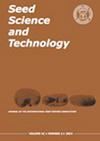特邀综述:种子成熟及其实际意义
IF 3
4区 农林科学
Q2 AGRONOMY
引用次数: 0
摘要
在作物生产中使用高活力种子的重要性日益增加。种子活力在后期成熟阶段,在储备沉积和达到最大干重之后发育。在这一阶段,种子被施加了各种保护机制,这些机制将有助于种子在脱离母体植物后的存活。这些机制包括产生保护性代谢物,如抗氧化剂和色素、特定蛋白质和叶绿素的降解。所有这些都是作为繁殖材料的种子的最大质量所必需的,因为它们有助于提高对各种生物和非生物胁迫的耐受性。物理卫生处理、储存期间的老化和病原体的威胁是种子在生产、加工和发芽过程中可能经历的一些压力。然而,在种子完全成熟的阶段收获种子和最大的活力是种子生产的一大挑战。对大多数种子来说,叶绿素水平的分析可以作为相对成熟度的衡量标准。这是一项相当敏感的技术,因为它利用了叶绿素的荧光特性,也可以用于升级含有相对较大比例不成熟种子的种子批次。分类后的种子组分也有助于研究种子成熟后期的过程和种子成熟后期获得的不同种子活力方面。本文章由计算机程序翻译,如有差异,请以英文原文为准。
Invited Review: Seed maturation and its practical implications
The use of high vigour seeds for crop production is increasing in importance. Seed vigour develops during the late maturation phase, after deposition of reserves and attainment of maximum dry weight. During this phase, various protective mechanisms are imposed in the seeds that will aid survival after release from the mother plant. These mechanisms include the production of protective metabolites such as antioxidants and pigments, specific proteins and degradation of chlorophyll. All are essential for maximum quality of seeds used as propagation material, since they aid in providing increased tolerance to diverse biotic and abiotic stresses. Physical sanitation treatments, ageing during storage and threat by pathogens are some of the stresses that the seeds can experience during production, processing and germination. However, harvesting seeds at the fully mature stage and with maximum vigour is a big challenge in seed production. For most seeds, analysis of chlorophyll levels can be used as a measure of relative maturity. This is a rather sensitive technique as it uses the fluorescence properties of chlorophyll, and can also be used for upgrading seed lots containing relatively large fractions of less mature seeds. Sorted seed fractions are also useful to study processes during late seed maturation and the different seed vigour aspects gained during late seed maturation.
求助全文
通过发布文献求助,成功后即可免费获取论文全文。
去求助
来源期刊

Seed Science and Technology
农林科学-农艺学
CiteScore
3.00
自引率
28.60%
发文量
36
审稿时长
>36 weeks
期刊介绍:
Seed Science and Technology (SST) is an international journal featuring original papers and articles on seed quality and physiology related to seed production, harvest, processing, sampling, storage, genetic conservation, habitat regeneration, distribution and testing. A journal that meets the needs of researchers, advisers and all those involved in the improvement and technical control of seed quality. Published every April, August and December.
 求助内容:
求助内容: 应助结果提醒方式:
应助结果提醒方式:


